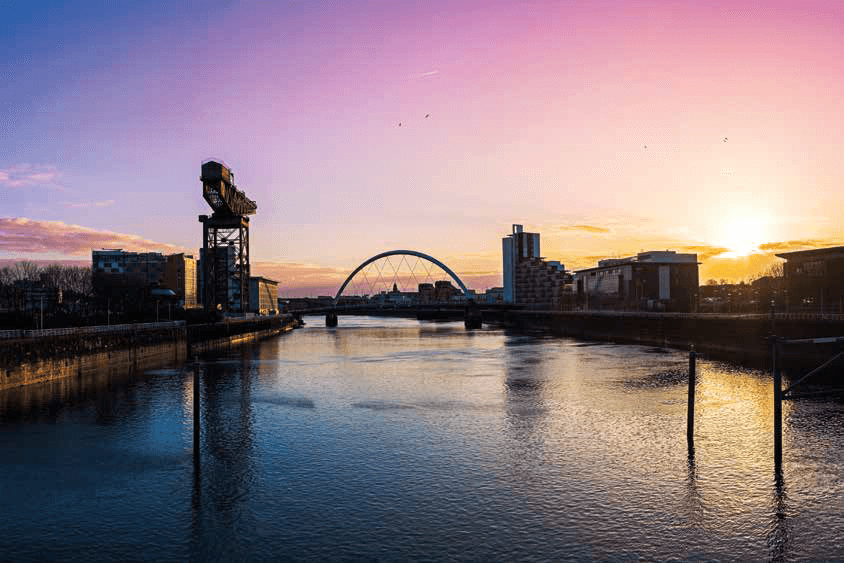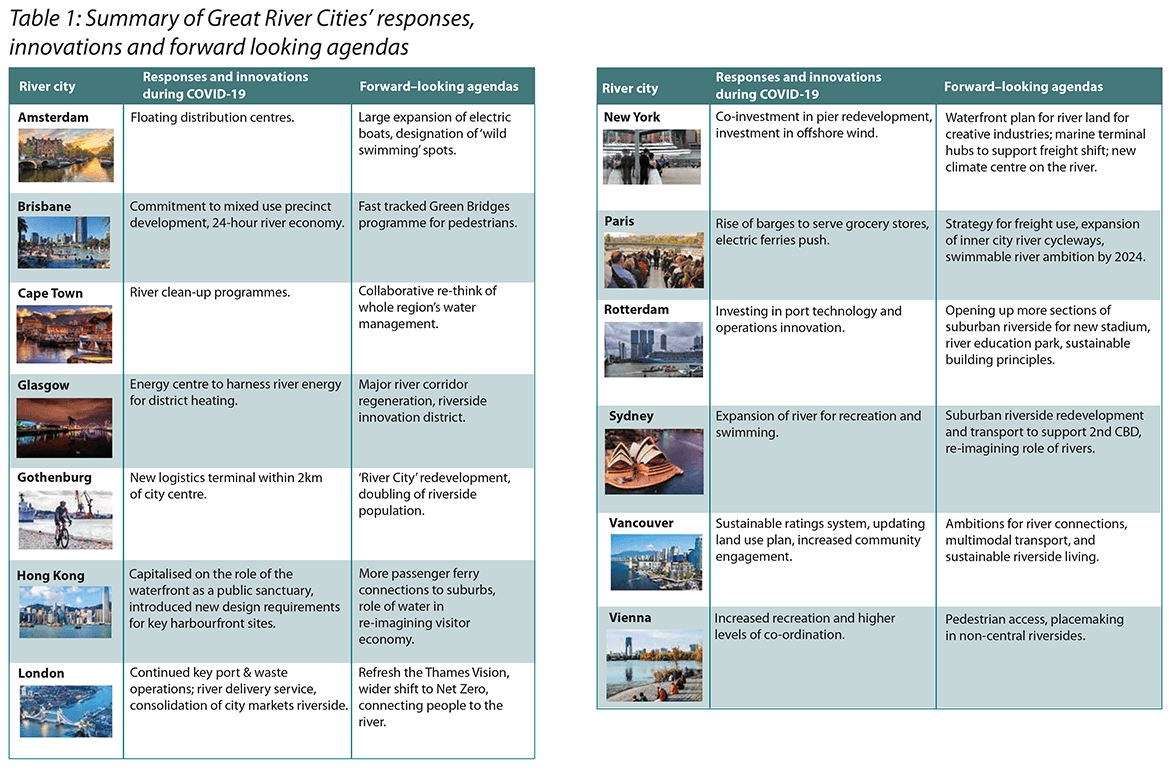Great River Cities: The Impact of COVID-19 on Long-Term Plans
Common Challenges – Shared Opportunities – Inspiration for the Future
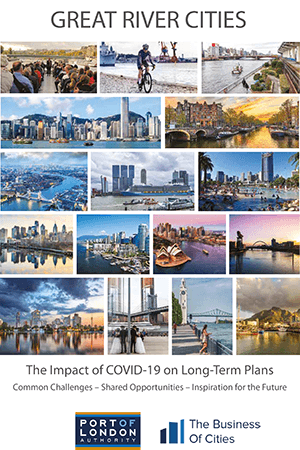 All over the world, rivers are the beating heart of the great cities through which they flow. Rivers were the reason why early cities were sited where they were and the trade routes they spawned became the foundation for those cities’ growth and prosperity. Today, rivers serve many constituencies. Rivers are for trade, for travel, for sport, for recreation, for environmental regeneration and, no less important, they are places to pause, lift our eyes and draw inspiration.
All over the world, rivers are the beating heart of the great cities through which they flow. Rivers were the reason why early cities were sited where they were and the trade routes they spawned became the foundation for those cities’ growth and prosperity. Today, rivers serve many constituencies. Rivers are for trade, for travel, for sport, for recreation, for environmental regeneration and, no less important, they are places to pause, lift our eyes and draw inspiration.
The original idea for bringing together the Great River Cities of the world came from a conversation with Vinit Kumar, my counterpart at the Kolkata Port Trust during Durga Puja 2018. We realised that as custodians of our great rivers we were not competitors. If you are planning a walk down the Thames Path, the banks of the Hooghly are not competing for your time and attention. And if you want to send goods from Deggendorf to Vienna, you’ll use the Danube not the Thames.
So, Great River Cities are not competitors in the conventional sense. But, as our research showed, the custodians of Great Rivers face common challenges and opportunities and, distinctively, we all have a passion for the rivers we serve. Our instinct was that there was much Great River Cities could learn from each other and from the ways they were responding to common challenges, not least the constant battle to manage finite river space in the face of ever-growing demands.
COVID-19 provided a compelling reason for looking into this more closely. We were curious to know how the pandemic was shaping cities’ plans and aspirations for their rivers. Is it speeding up developments or slowing them down? What role are rivers playing in individual city’s COVID-19 response?
Right now, Great River Cities are all working flat out to mitigate the short-term impact of COVID-19 on their stakeholders. This is unsurprising given the dominance of sea transport in global trade flows. But, interestingly, those we interviewed were also committed to adapting and accelerating their existing development plans and re-imagining the future role of the river in their cities.
Sharing our experiences of dealing with common challenges can only help us all advance more quickly and effectively than pursuing our goals in splendid isolation.
Our first webinar attracted over 200 participants from around the world. This publication draws together our research and their insights. We thank everyone for their contributions. Starting this autumn, we plan further webinars on the priority areas for further collaboration described in this document.
If you want to find out more, join us or, better still, help shape the debate please get in touch via: [email protected].
 Christopher Rodrigues CBE
Christopher Rodrigues CBE
Chairman
Port of London Authority
Custodians of the Tidal Thames
(one of the World’s Great River Cities)
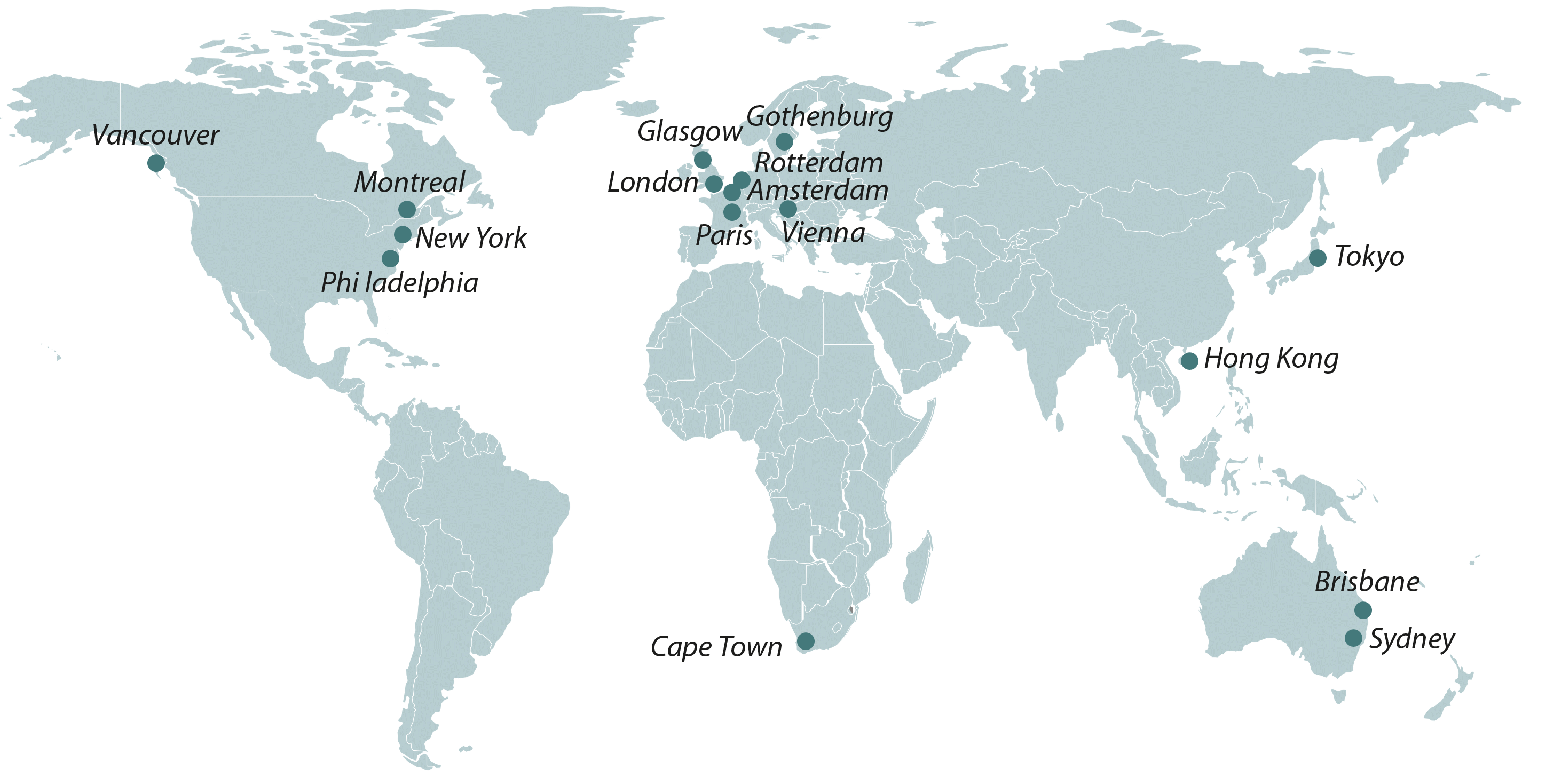
Introduction
For much of the last 20 years, the river has been an essential part of the resurgence and re-urbanisation of great cities around the world.
As cities expanded their role as global hubs for trade, visitors, talent, innovation and lifestyle, their urban rivers experienced soaring demand, becoming enablers of commerce, leisure, enjoyment, amenity and housing. They have once again become indispensable assets to many of the world’s leading cities. Rivers have underpinned spatial development, new industries, and placemaking. With this demand came new pressures and expectations about how to make the river green and sustainable, and to maximise its contribution to urban resilience in the face of climate change.
In amongst this ongoing river city evolution, COVID-19 has been an unprecedented shock to life, economies and systems. In response, river authorities, operators, and regulators have been racing to ensure that river operations can continue safely and healthily, and to protect and mitigate against the financial and operational impacts of a dramatically reduced demand due to the pandemic.
At the same time, many are also witnessing surprising new patterns of demand and behaviour. They recognise that this is a time when collaboration, innovation and leadership will reap strong returns. Amid the uncertainty, some are spotting momentum shifts in terms of how and who will use the river in future, re-thinking the balance of uses and activities to which rivers can and will play host. This has led to the exploration of new ventures and experiments.
This paper sets out recent trends and responses across 15 of the world’s largest river cities (see map above). It reflects findings from desk research, combined with interviews with leaders and decision makers closely involved in their city’s river, port or harbour.
The evident conclusion is that COVID and other influences are increasing demand for river activity, in what is ultimately a finite space. This results in a new set of challenges around how to make the most of city rivers, the assets along the river, and how to create a broader sense of place and attachment.
Different senses in which river leaders and planners are responding to COVID-19 emerged as variously: a crisis to be managed (mitigation); an opportunity to continue with necessary changes (adapting and accelerating); and a stimulus for bigger thinking about the role of the river in a world where cities’ centres of gravity will become more varied and digitised (reimagining).
In summary the approaches are:
- Mitigating: managing the effects of COVID-19 on demand for river passenger travel, commercial operations, tourism, and securing public health and safety during the pandemic. This pandemic management is ongoing, spanning almost 12 months and addressing the near-term horizon out to the hoped-for recovery to greater normality.
- Adopting and accelerating: the ways in which cities have adjusted to deliver on longer-term agenda for cleaner, greener and more vibrant rivers. Forming gradually for the last five to ten years, these priorities have been crystallised by the pandemic. They have been shared and reinforced by changing behaviours and relationships that people have had with their rivers, and the opportunity to increase the pace of adaptation and reform.
- Reimagining: rethinking the roles that the river can play in a post-COVID-19 context. Rivers will be part of how we respond to change, driving mobility in a more distributed model of urbanisation, offering new options for visitors and tourists, reinforcing their place as the critical DNA of the city and civic belonging in a more digitised world. River space will start to demand higher levels of, and shared, responsibility.
Figure 1 sets out specific actions being taken in each of the three types of response.
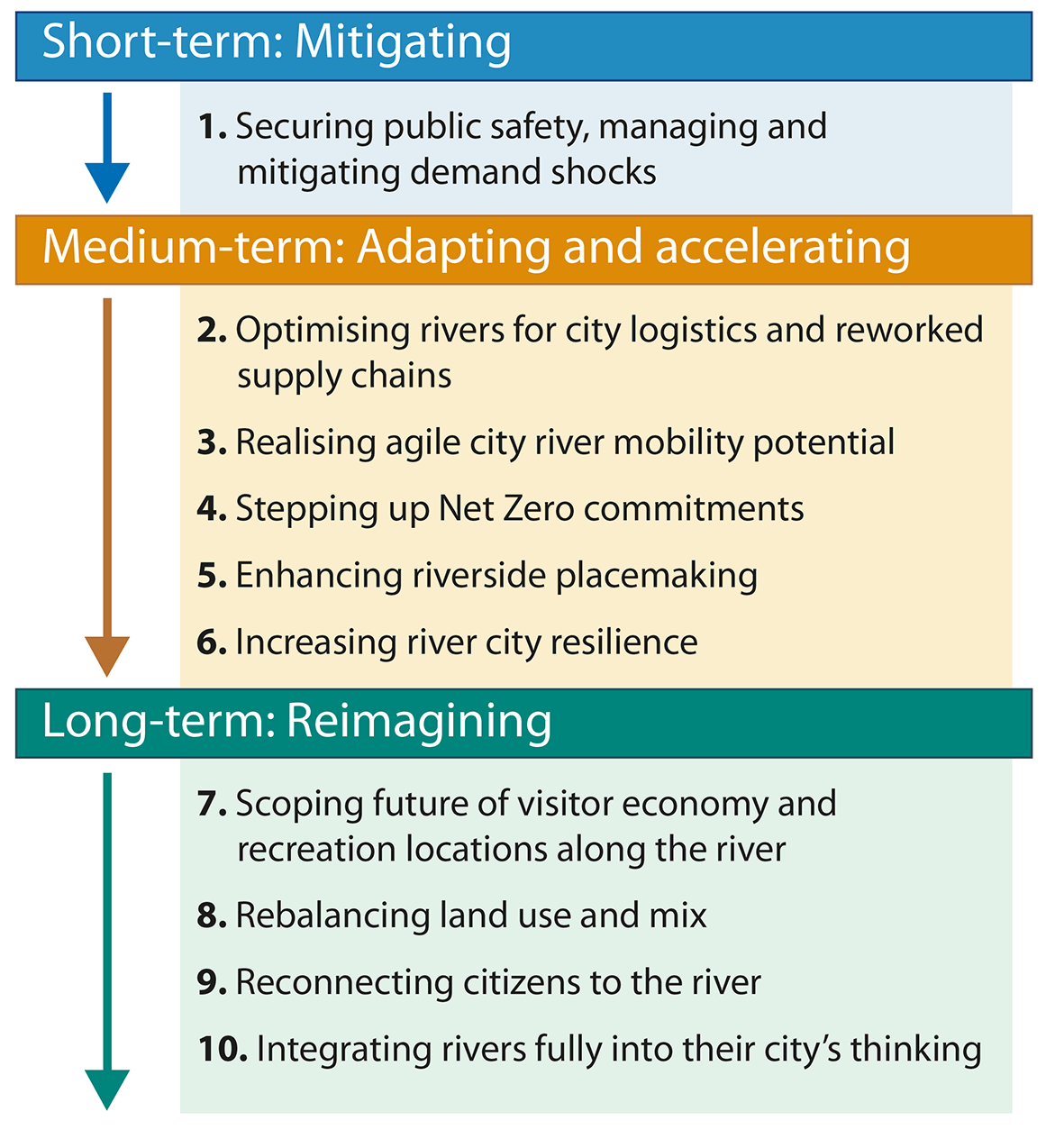
The range of responses, from mitigation through to reimagining, is not comprehensive. It does though capture the essence of activities, policies, investments and ambitions that authorities and leaders of city rivers are adopting in the rapidly changing circumstances of COVID-19. This report takes each of the ten responses set out in Figure 1, examining what they mean in practical terms on cities’ rivers and riverbanks, before concluding and looking to common questions for Great River Cities which could benefit from future collaborations.
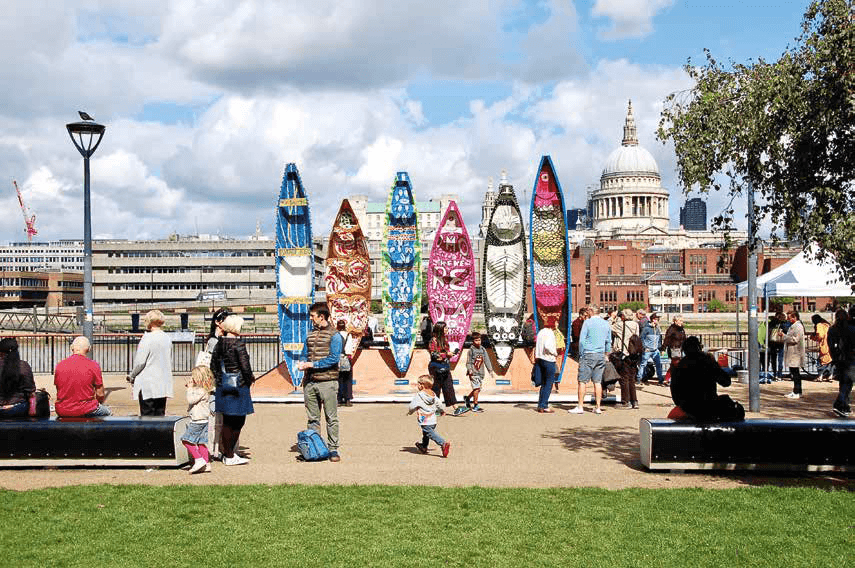
Short-term: Mitigating
1. Securing public safety, managing and mitigating demand shocks
COVID-19 has led to more than 12 months of markedly reduced economic and trade activity in the majority of major cities, with knock-on effects on the kinds of demand placed on the river.
In general, interviewees distinguish between short-term ‘pre-vaccine’ disruption; and medium-to long-term disruption, which many perceive may continue for up to ten years. The full extent of disruption to cruise ship, container ship, barge traffic and tourist operations remains to be seen. The priority has been to maintain adequate supply of goods, ensure safe river use, give precedence to essential services, and coordinate changes effectively. Many interviewees remark on the level of resilience their rivers have shown in the circumstances.
In many cases, subsidy and stimulus for hard-hit river activities has been delayed or unforthcoming as governments respond to other transport modes first. Despite this uncertainty, governing agencies continue to work on several fronts to ensure that their rivers fulfil all their functions and exercise responsible stewardship by working together with others.
The key priorities have been:
- Securing public safety, ensuring that boats, piers and other areas of congregation are appropriately socially distanced, and that opportunities for fresh air are optimised. Interviewees explained that adapting to changing regulations of who, how and when the water can be used has been an important monitoring, communication and organisation task.
- Maintaining the usage of passenger boats and container goods. Leaders in several cities report that both passenger and container traffic have remained surprisingly robust and, in some cases, exceeded pre-COVID levels. However, others have reported major and sustained downturns in leisure usage, partly due to travel restrictions, partly due to the structure of the central business district (CBD), and partly because of behaviour change. Cities such as Brisbane, reorganised and upgraded their cross-river ferry services in preparation for 2021.
- Ensuring key river waste and distribution functions continue uninterrupted. The port of Montreal has invested and partnered with tech firms to create artificial intelligence (AI) tools to read customs declarations and target fast supply chains, focusing on essential goods and creating faster delivery routes for those items. In London, the continued river transport of non-recyclables by waste management firm Cory Riverside Energy has been very important.
- Maintaining the investment rate and delivery timetable for new river infrastructure, including new or enhanced terminals for freight and merchandise to accommodate the forecast increase in water transport hubs (see Section 2). In Brisbane, a series of major waterfront precinct projects across the city centre have been determinedly sustained, while in New York the approvals and design process has continued to facilitate the Governors Island climate centre project, a mixed-use development in the middle of the river that promotes climate change research. Some cities have also been focusing on the long-term investment in port facilities in the meantime. Vancouver’s Port Authority is pursuing a US$1.5bn public-private funded additional three berth marine container terminal, while Singapore will soon complete the US$1.8bn four-phase Tuas Port.
Despite efforts to maintain investment and patronage of the river, many cities have seen a reduction especially in the volume of passenger ferries and leisure boating. In New York and London, for example, the resumption of ferry services has been held back by both periodic lockdowns and the absence of international tourists due to travel restrictions. Prolonged reductions in footfall and revenue are also presenting major challenges for authorities and operators.
A key priority in many locations is to use the crisis to demonstrate the resilience of the river and its profound economic value as it delivers services to entire ecosystems while also directly and indirectly sustaining many jobs and livelihoods. Securing more reliable forms of investment is a conversation happening in many river cities.
2. Optimising rivers for urban logistics and reworked supply chains
Cities are exploring the potential of rivers to play larger and more agile logistics functions, and the possibility of using barges and container ships to move goods. Some cities are already working directly with delivery and logistics firms to accommodate new ways of transporting goods, capitalising on the acceleration of e-commerce.
Many cities are planning to expand river terminals and wharves within the next five years, and shift to a multimodal model. This has involved completing development, safeguarding locations for future river use, and investing in rail and last mile connections.
- In Philadelphia, a 1,300-acre riverside refinery complex just 6km from city centre is now being rebuilt as an environmentally responsible centre of e-commerce, part funded by a Canadian pension fund as part of a long-term vision.
- In Gothenburg, is responding to demand with US$44m to build a new 220,000 square metre terminal less than 2km away from the city centre by 2025.
- In Vancouver, US$110m is being invested in two projects led by the Port Authority with the nation’s railway agency, to include new rail tracks for freight. Vienna is also exploring ways to strengthen the connection between the Danube Harbour and the rail cargo terminal, and reassessing the role of freight logistics along the river.
In recognition of the potential evolution of river logistics towards increasing light freight, port authorities, consumer chains and local governments are working to achieve stronger links between ports, river distribution centres, and the final destinations of goods:
- In Paris, city government and local grocery chains have accelerated the use of canals to deliver food to stores. A prominent example is Franprix en Seine, a grocery store using barges and local trucks to supply 135 of its stores within the city.
- In London, a new DHL delivery service combines electric vehicles, riverboats and last-mile bicycles to enhance citywide delivery of goods. Plans are also underway to consolidate a number of London’s markets at a riverside site east of the city.
- In Amsterdam, municipal electric boats are becomingly more extensively used to transport goods and commodities throughout the river and canal system. Floating distribution centres in the form of special boats transport packages to points from where couriers on electric bicycles deliver them to their final destination.
Towards a new role for river freight: Freight NYC
Freight NYC plans for a shift towards a hub and spoke approach – shipping containers or palletised cargo would move from large regional container terminals to various points in the city on barges via waterways – taking trucks off the roads and reducing road congestion and pollution. The overall aim is to eliminate 40 million truck miles and 71,500 metric tonnes of greenhouse gas emissions per year. Key parts of the strategy include: two new terminals, convening a regional barge council comprising port authorities, maritime businesses, and shippers, to develop a whole region approach, and more regular maintenance dredging of waterways. |
"We’re really focusing on exploring the use of the river to alleviate carbon costs. The increased competition between freight and passenger rail is synonymous with how e ective less carbon-intensive trade practices and increased capacity cargo movement can be" - Interviewee
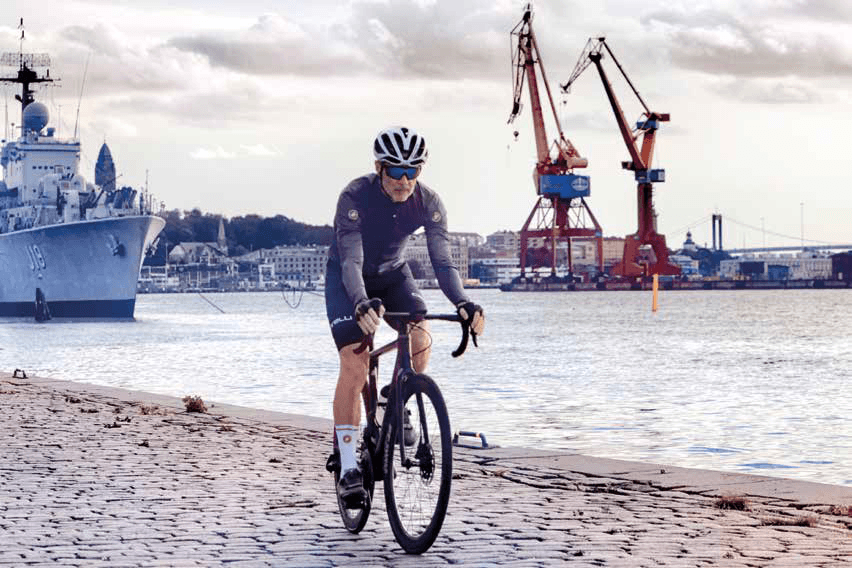 Gothenburg. Source: Martin Magnemyr, Unsplash, CC by SA 2.0.
|
3. Realising agile city river mobility potential
The mobility potential of the river has been an important point of realisation during COVID-19 for many river leaders, planners and advocates. How the river can serve a more distributed kind of urban movement, not only suburb to city centre, but also a wider mix to suit a more discretionary and digitally connected workforce, is a key priority.
Due to the open-air nature of river-based transport, many cities found that ferry usage was steadier than metro usage during the pandemic. Meanwhile, more cities are recognising the potential to create more ferry links within their core areas and between city centres and their suburbs, and to unlock more active mobility through bridges, riverbanks and connective streets.
Increased use of ferries as public transportation
River cities in Europe and North America are in the process of adding ferries to the public transportation fleet, and enhancing travel options between different islands and suburbs.
- In Paris, more electric ferries are being added to the public transportation system.
- Hong Kong is actively considering expansion of the role of ferries in connecting outer suburbs and New Towns to the centre and other locations. Demand for ferries during lockdown has alerted policymakers to the potential for water transport to serve a managed decentralisation of activities.
Multimodal connections across and around the river
Most cities have completed plans and are in construction phases to create multimodal connections through the river (rail, pedestrian, bikers).
- Sydney, with the financial backing from the State Government of US$11m, is proceeding to build a boardwalk to complete a new link in a pedestrian and cycle path along the banks of Parramatta River.
- New York’s Hudson River Tunnel project aims to increase freight and train passenger capacity, decreasing rail bottleneck issues for commuters and good transportation.
- Digital connectivity to support flexible working waterfronts. Interviewees noted the growing emphasis that has started to be placed on making internet access more available on river vessels and waterfronts throughout the whole metropolitan area, not only in or near the city centre. Digital infrastructure is also viewed as an important catalyst to opening up more of the waterfronts for various kinds of commercial and logistical activity.
Brisbane: pedestrianising along and across the river
The project is fast-tracking the construction of two of the four bridges, undergoing procurement during the pandemic and to be built by 2023 (estimated to cost US$180m). Two more are in the early planning and design stage. Photo Source: SiggyNowak, CC by SA 2.0. |
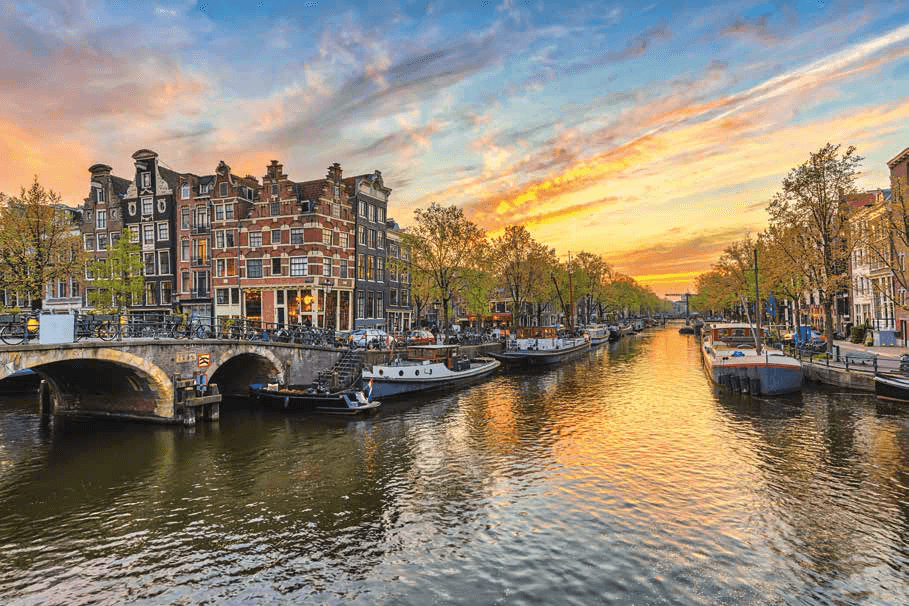
Amstel. Source: ethanhjy, Unsplash, CC by SA 2.0.
"We’ve done really well during COVID to keep trade going and continue to work on accommodating the stream of applications to lower emissions and intensity of uses" - Interviewee
4. Stepping up Net Zero commitments
The reduction in commuting and pollution associated with COVID-19 lockdowns has given more people experience of cleaner and greener urban living. The pandemic has also encouraged greater awareness and reflection about impending climate change threats. Rivers’ natural currents and proximity to open space, are also emerging as an obvious choice for siting new investments in renewable energies.
Many river and port authorities have been extremely active adapting enquiries to Net Zero demands, and devising new strategies of their own.
London was the first UK port with an air quality strategy, with subsequent work including inland vessel emissions reduction mapping; the Port of London Authority has fully scoped plans for transition to Net Zero by 2040 or earlier.
Investing in river’s energy generation potential
- New York State is investing in underground tidal turbines in the East River to experiment with energy harvesting from the tides. The US$7m experiment is already underway and provides power to several commercial establishments on Roosevelt Island. Separately the Port Authority, the City and the State continue to invest in offshore wind, approving two wind farms in 2021 one of which is located approximately 30 miles away from NYC. The two projects will create 1.7 GW of renewable energy by 2024.
River for district heating
- Glasgow uses 5.2 MW heat pumps to take water from the river and use it to deliver heating and hot water as part of a district heating system that is three times more efficient than gas boilers to heat local homes.
Platforms and regulations to minimise emissions
- In Rotterdam, the port authority is continuing to build its company PortXchange to roll out the Pronto platform, which optimises port calls to reduce CO2 emissions globally in shipping. With Pronto, vessels can sail ‘just in time’ to ports which reduces CO2 emissions as well as anchor time, resulting in lower NOx emissions.
- Increasing barge use for last mile transportation (Paris), using technology to increase shut down time for large shipping boats (Vancouver), and requiring that only electric boats be allowed on waterways (Amsterdam).
Commitment to low emissions engines
- Paris: The city’s new 2030 climate action plan now calls to establish a clean engine river shuttle service for passengers before 2030, and increase the use of the river for freight.
- Amsterdam: Through instituting a series of new regulations, the city plans to only allow electric boats within the canals by 2025.
Vancouver’s green port and river ambitions
A number of key projects and investments in sustainable development models are supporting more people to live, work and play close to the river (Southeast False Creek, East Fraser Lands). Vancouver’s recently completed terminal project will reduce greenhouse gas emissions by allowing ships to shut down their diesel engines and connect to an electrical grid supplied by renewable energy sources (US$7 m). |
5. Enhancing riverside placemaking
The role that rivers have played in COVID-19 as a place of relaxation and enjoyment has been encouraging more agencies and developments to explore ways to connect people to the water through new parks and activities. Many observers in different cities have spoken of the opportunity to deliver a higher quality of place along many stretches of their river, improving the vibrancy and greenery right by the riverside and opening up more sterile sections.
Several leading cities are now developing more collaborative approaches to riverside placemaking. In some cities with land use instruments, innovative placemaking approaches are financed via agreements with developers (density bonuses, zoning variances). Some have famously been directly banning cars from the riverside. Others are creating new links to the river by instituting new requirements for developers to invest in the waterfront access.
There is a growing consensus that riverfront placemaking projects do not need to be grand plazas and promenades, and that smaller-scale interventions such as parks, picnic spots and urban gardens can also be effective in stimulating footfall and demand.
Providing waterfront access to pedestrians
- Sydney’s state government is actively considering a continuous 80km river walkway between the Opera House and the second central business district (CBD) of Parramatta, expanding access from 22km.
- In New York, developers along the waterfront are co-financing pier rehabilitation as part of the approval process. The latest example of this is Pier 9 along the Hudson.
- Local government in Paris continues to regulate for river roads to become rapid cycle ways, and pro-pedestrian pro-leisure pavements.
- In Brisbane, projects to provide pedestrian access to the waterfront continue to move at full speed. The US$2.5bn Queen’s Wharf adds to the momentum on public realm and in conjunction with precincts across the CBD, are reconnecting people with the full stretch of the inner city river, and shifting Brisbane towards a 24-hour city centre economy.
Improved riverfront design standards
- In Vienna, the Marina Deck is a signature new residential development that also includes a pedestrian bridge connection to the other side of the Danube, reflecting a growing recognition that access to both sides of the river is essential.
- In New York, the Waterfront Alliance has helped to set up Waterfront Edge Design Guidelines (WEDG) a nationally applicable standard for Excellence in Waterfront Design. The accreditation programme, which works similarly to the Leadership in Energy and Environmental Design (LEED) certification system for green buildings, focuses on three key pillars: resilience, ecology and access to promote resilient development.
Towards swimmable rivers
While not all cities are able to make their water swimmable in the medium-term, a vanguard of global cities is now pursuing efforts to make the water clean enough to swim and to encourage more people to sample and enjoy the river for longer. This requires vigilance on water quality, currents, other users, and wider weather patterns:
- Paris has invested around US$1.2bn to make its water swimmable by 2024.
- Sydney is creating new swimming spots all along the river, to begin by 2021/22.
- In Cape Town and Hong Kong, river clean-up programmes are prioritising drainage improvements, ecology, and new litter catchment technologies.
Hong Kong: Central Harbourfront reclamation to ensure design qualityHong Kong has recently amended the tendering approach for one of the largest and most strategic new waterfront-based land reclamation projects in the city centre to more squarely take into consideration the quality of design. This important step aims to set an example of how signature waterside projects can prioritise quality, and show how value can be enhanced through the provision of better landscaping, public realm and connectivity. |
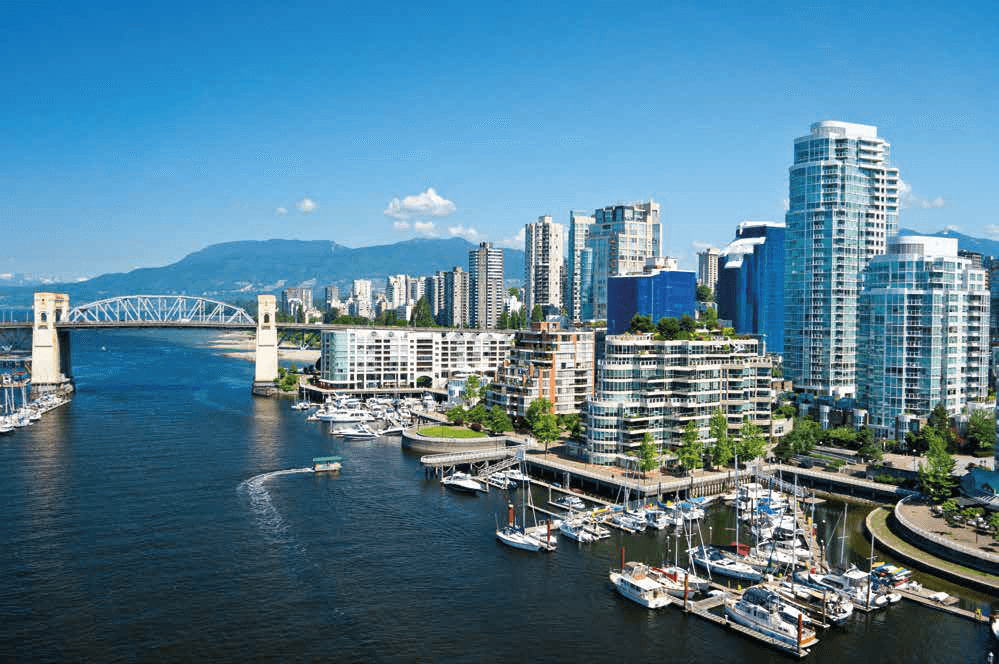
Vancouver. Source: jaspion82, CC by SA 2.0.
"The shift towards sustainable infrastructure… has led to the creation of a ratings system that will be used internally and for port tenants" - Interviewee
6. Increasing river city resilience
Reaffirmed commitment to rivers’ role in city resilience has been a notable feature of 2020. This resilience has spanned public health and safety, environmental protection and infrastructure mitigation.
With rising sea levels, increased risk of flooding due to more frequent and stronger storm events, and concerns of ageing and failing infrastructure, cities are progressing through COVID-19 a number of mega-projects combined with smaller-scale tactical interventions, and improved management of risks.
Innovative flood risk management
- Launched after substantial public consultation, the US$340m BIG U project is designed to mitigate flood risks along New York’s waterfront by using open space with rain storage capacity, and is currently proposing a formal new Zoning for Coastal Flood Resiliency.
- City government in Paris continues to invest in rainwater gardens and stormwater management structures to increase ground permeability. A new project to separate the combined sewer system by 2024, will reduce sewage release during heavy rainstorms. The city is also creating crisis simulations to prepare for various water threats.
- The G-Cans Project in Tokyo is the world’s largest underground flood water diversion facility, which operates by channelling the overflowing flood waters from the rivers within Tokyo to five silos through tunnels.
Greening port facilities and sea level rise adaptation
- The new terminal in Gothenburg is being built using around 350,000m2 of dredge spoils originating from the Göta älv, toxic to the river but manageable on land.
- The Port of Brisbane has been investing A$1million to rehabilitate 1.7km of nearby Creek through bank re-profiling, the installation of 4 cross-bed grade control structures, and innovative techniques to identify sources of sediment pollution.
Progressing London’s tunnel to protect the city from stormwater and sewage overflows
This essential expansion of London’s sewerage network has involved ongoing work through COVID-19 across more than 24 construction sites in London, many located on the river edge. In addition to reducing untreated water overflow to the Thames, the US$5.5bn project features new open spaces, provides spaces for art display and educational tools for current and future environmental stewards. The project has been slightly delayed, with COVID-19 causing a brief reduction from 24 active sites to three during the early virus peak, but commitment to project delivery by 2025 has been re-iterated. |
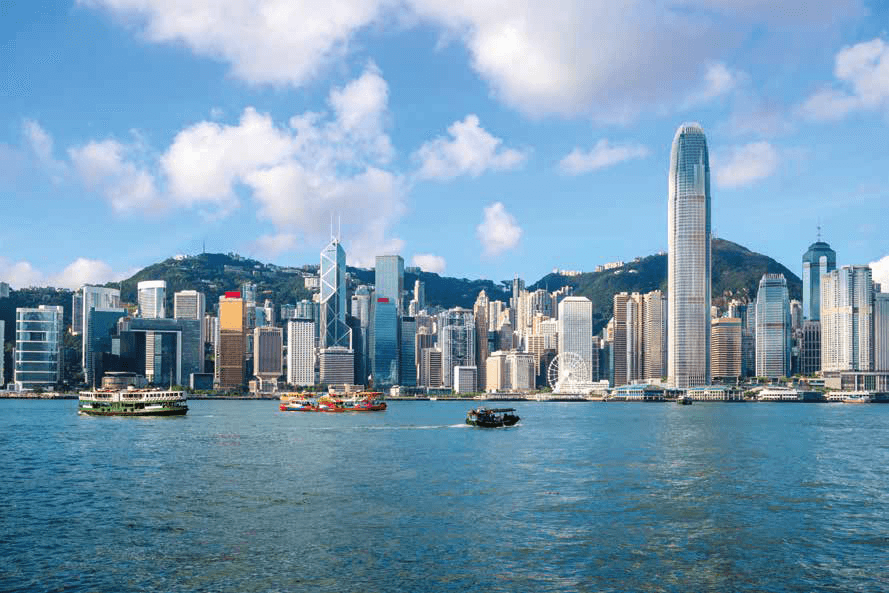
Longer-term: Reimagining
7. Scoping future of visitor economy and recreation locations along the river
River leaders and commercial operators are starting to rethink whether the river can diversify beyond international tourism and retail dependence. Some are trying to reimagine the visitor economy and shift beyond what is perceived by some to be a low value added, ‘transactional’ tourism model.
Opportunities to make the river a place and a venue of culture, and a deliberate switch from quantity to quality, are actively under consideration in cities from Paris to Hong Kong and Brisbane.
Cities have heavily invested in moving entertainment facilities to ensure better usage and catalyse other investments along the water.
- In an attempt to diversify the city’s visitor offer and encourage people living outside the city core to make use of the river, Sydney’s government invested in moving one of its prominent museums to the new riverside Powerhouse Precinct, and created a design contest to achieve the highest possible standards in placemaking and attract new residents and visitors.
- The Reinventing the Seine project in Paris, launched in 2019, aims to improve placemaking and vitality by improving the accessibility of banks, and adding new spaces for residents and visitors to experience and exchange. An example is Fluctuart, a floating urban art centre featuring eco-friendly aquatic complexes, restaurants, and other cultural activities.
New proposed developments on previously non-developed land continue to make it through zoning approvals to create hubs for living in places dealing with sea level rise and climate change.
- In New York, Governors Island’s new climate centre proposal continues to make it through the zoning approvals to become a major hub for the city’s efforts to fight climate change with a proposed 350,000m2 mixed use development that would serve as a space for climate change experts to conduct and showcase research. The idea is for it to become a public 'living lab' that serves technology, visitor and cultural functions.
Rotterdam: towards a new kind of sport and leisure river environment
Meanwhile a new park, made entirely of plastic waste, is helping to create connections between humans and nature in ways that previously did not exist. The focus of the development is not only on creating a new place, but also on pursuing green commitments and educating residents on the water’s ecosystem. |
"We are trying to make sure that the working waterfront is still a priority when making land use and development decisions" - Interviewee
8. Re-balancing of land use and mix
COVID-19 is altering patterns of movements and flows between dense inner cities and outer suburbs. A more distributed pattern of urbanisation is emerging with more activities happening locally outside of inner cities. Rivers present natural geographies for future markets – housing, labour and amenity – and these more distributed patterns of urban movement.
In this context many cities now view waterside developments as a means to provide new investment in sometimes disadvantaged communities, often in suburbs, and to mix light industrial uses with new recreation and commercial areas.
There also remains a need to ensure strategic riverside sites are retained for cargo handling so that the river’s potential as a low carbon superhighway can be realised.
In London, this is through a unique policy safeguarding key sites for port use.
Redevelopment projects along city rivers that have retained momentum in COVID-19 include:
High calibre mixed use
- In Tokyo, a new development known as Tokyo Mizumachi promotes a prosperous waterside development connecting Asakusa and Tokyo Skytree Town in collaboration with Sumida Ward for the purpose of creating a new attractive space in Tokyo.
- The Port of Vancouver is working on an updated land-use plan with policy pieces that support mandate and policy reaffirmation and intensification of existing projects.
Unlocking piers in more varied inner city and suburban locations
- New York City’s Department of Planning continues to work on collaboratively transforming industrial piers into new areas for recreation. Examples include the Pier 97 project (US$38 million), Hudson River Park, the South Waterfront Project and Hoboken.
Land for creative and advanced industries and 24-hour economy
- Securing former industrial river land for future use by the ÿlm industry and sound stages is a strategic priority for riverfronts in New York.
- The proposed waterfront precincts in Brisbane not only provide new placemaking opportunities to attract talent and companies, but would also create more of an 18-hour and 24-hour economy along the water through the city centre.
Floating green buildings
- New developments on the river in Rotterdam are prioritising sustainable building principles. Projects include a timber office building that will float on the Rijnhaven river port. The project, which began in 2020, is designed to be energy-neutral and self-sufficient. Expected to remain in port for five to ten years, the design boasts state-of-the-art sustainability measures such as heat exchange through the harbour water.
Glasgow: diversifying the waterfront economy into the inner suburbsGlasgow’s city government has maintained its focus on the opportunity of the Clyde Valley area as a site of physical and economic innovation. After previous cycles of challenge in the 60ha regeneration vision, the city, university and other stakeholders are committed to implementing a new approach that includes an innovation district, a new bridge, 250 new homes, several new business developments, and a series of new cycle routes to better link river-bank communities. The focus is on job creation and accessibility within and beyond the city centre. It has also catalysed demand for a new US$130 million harbour-side retail development that is now in train.
|
9. Re-connecting citizens to the river
For many great river cities, the waterfronts have proved a hugely valued refuge during COVID-19-related lockdowns for people to escape their homes, enjoy fresh air safely, and reconnect with friends and loved ones. Once again, water has been a magnet for urban humanity, that has proved calming and inspiring, and inviting a sense of connection with the city and its history and scale.
River cities are seizing on increased footfall and connection to build a greater sense of attachment. Many are looking to develop the river as an inclusive and educational space, and a place for sport, culture, community, volunteering, and housing.
Interviewees noted at least three aspects of community engagement and inspiration that have been prominent since the start of COVID-19:
- Cities with open space along their waterfronts are attracting new kinds of local users in increasing numbers. This brings with it a responsibility to extend that attachment and also ensure health and safety, proper water preparation, and foster conviviality.
- The need to re-establish the link between rivers and residents – reminding people that cities are where they are in a large point due to location and character of their rivers.
-
Citizen support is vital for longer-term sustainability and success of river initiatives – and this requires converting ‘residents as spectators’ to ‘residents as actors.’ The growth in people using the waterfront and riverside parks and shores is also encouraging leaders and agencies to think about how to engage communities more effectively in the decisions for the future of the river, and the role of water in the city’s long-term proposition.
- In Vancouver, increased access to the community thanks to the normalisation of use of online platforms as community engagement tools has improved visibility on existing decision-making processes, which has increased engagement across the board.
- The Re-imagining Hong Kong brand programme is considering the role of the harbour in the future high-quality positioning of the city.
- In London, a refresh of the twenty year development framework for the river, the Thames Vision, will be rooted in sustainable growth, the zero energy transition and involve substantial engagement with multiple stakeholder communities.
|
New York City’s forthcoming Comprehensive Waterfront Plan in 2021 enlisted a record number of citizens to reimagine the role of the water in civic life. It has prioritised opportunities for lower income communities and communities of colour to engage in the process, including virtually since COVID-19. The ten-year plan will identify a variety of new locations, including economic development options along the water as well as providing more public access to the waterfront. It will lay out a vision for policy and site-specific recommendations. |
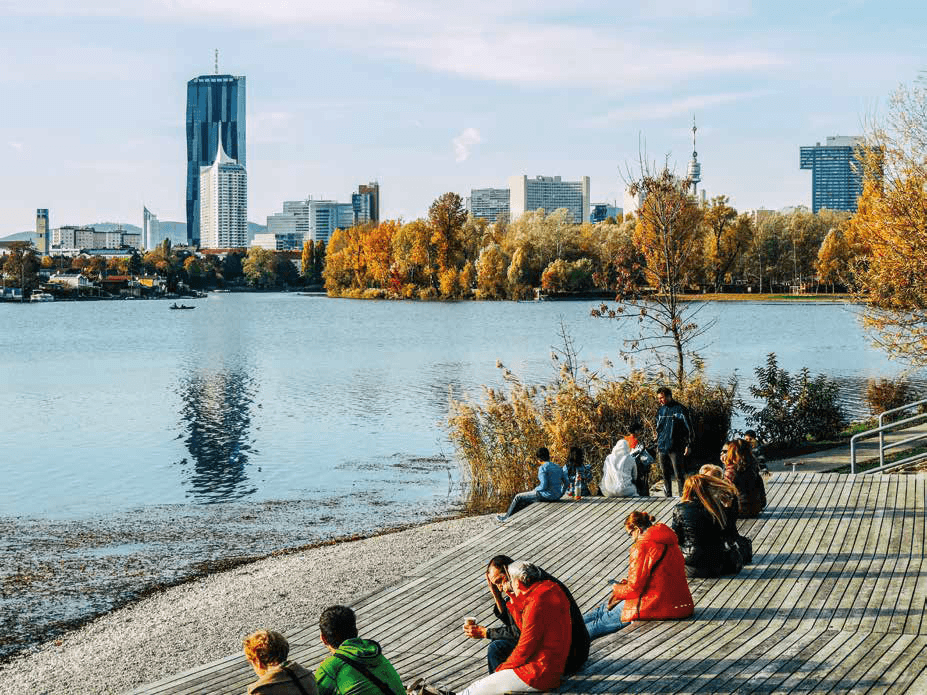
Danube: (c) City of Vienna, by Christian Fürthner
10. Integrating rivers fully into their city’s thinking
With rivers becoming recognised as a catalyst for action in cities’ quests to act on multiple agendas simultaneously (e.g. mobility, transport, climate change, and place making), there is now more than ever an imperative to shift to inclusive whole city visions that create lasting coalitions for change.
More cities are coming to the understanding that rivers cannot be managed in isolation, and that they are part of complex systems that encompass not only the river itself, but also the surrounding mix of jobs, amenities and activities the river supports.
COVID-19 has seen more river management activities become part of a wider conversation for the entire city, involving both engineering, economy and planning-related approaches. There are many examples of the governance of rivers shifting to take into account these realities, both in terms of increasing the scale at which governance takes place or improving connections between the different organisations with a stake in river health.
- For Vienna, the highly complex governance of the river is starting to evolve, with the wider Danube Commission helping to improve around the maintenance and improvement of navigation conditions on the river. It is proving responsive in its duties to consult and make recommendations about the river, and establish a uniform system of traffic and safety regulations. More broadly, there are signs that the city is able to create more of a common vision and establish a shared perception of the importance of the river and its needs across stakeholders.
- To ensure a proper collaboration between stakeholders along the Seine, different planning agencies have been working on creating a new vision for the river from Paris to the English Channel, meeting with stakeholders online and ensuring that all planning agencies are present for the various decision-making agencies.
River clean-up and new water activities are only part of the solution in tapping the river ecosystem for economic development, providing more spaces for gathering, re-engaging with citizens, and promoting the Net Zero carbon agenda, amongst other things. Cities are looking at a more comprehensive governance that also includes working with built environment experts to consider systems thinking and spatial interventions.
Cape Town: rethinking water governanceCape Town’s shift towards rethinking river and water supply governance followed the 2018 water supply crisis, when drought-like conditions meant the city was at one point around three months from fully running out of water. As well as restricting water supply and pressure, the City of Cape Town worked hard to get residents, businesses and agricultural companies on board with a host of water-saving initiatives that also have implications on water quality and river resilience. Since the crisis, the city has been part of a multi-stakeholder platform in collaboration with the OECD to coordinate efforts and improve governance and decision-making. The Western Cape Economic Development Partnership has also been working as an intermediary, with provincial and local government, and with water-user forums, to help governments, providers and users to collaborate better and to find shared solutions to common issues. The result is that more stakeholders are firm partners, prepare joint communications, and share data. |
Conclusion
The insights gathered by The Business of Cities show the many ways in which Great River Cities’ plans for their most valuable, riverine asset have been shaped by the COVID-19 pandemic. This is manifest across the short-, medium-and long-term, with city authorities and partners variously looking to mitigate immediate impacts, bring forward mid-term plans and reimagine the more distant future.
We’ve seen how different cities are tackling the challenges of optimising river city logistics, stepping up Net Zero commitments and reconnecting citizens to the river. It’s an inspirational mix of sometimes similar, sometimes different solutions to common problems. A summary of city responses can be found in Table 1.
We found leaders and organisers of city rivers are asking themselves a number of common questions about the future in particular wrestling with the challenge of making best use of finite, inelastic river space in evolving, growing and truly elastic cities. These shared questions are set out in the box below.
We hope that sharing these questions will act as a catalyst for further debate. We will be engaging with the cities who were involved in this initial report to review the questions and discuss how we address them to best effect in our next seminar, in autumn 2021.
Collaborating more closely in this way will provide a platform for Great River Cities to share relevant experience and deliver better managed river cities, more quickly for our many stakeholders.
Great River Cities’ Shared Questions
|
Click on the chart to enlarge in a new tab.
About the Port of London Authority
 As custodians of the tidal Thames, the PLA holds the river in trust. It works to hand the river to future generations in a better condition, realising the goals of the Thames Vision.
As custodians of the tidal Thames, the PLA holds the river in trust. It works to hand the river to future generations in a better condition, realising the goals of the Thames Vision.
The tidal Thames is home to one of the UK’s biggest ports, the busiest inland waterway for freight and passengers and a growing centre for sporting activity. It is also a thriving habitat, home to 125 different species of fish, 3,000 seals and more than 300,000 overwintering birds.
The port plays a key role as part of supply chains serving the UK markets of London, the south east and beyond. Over 45,000 jobs depend on the port, which generates more than £4.5 billion in economic value added annually.
The Thames Vision is a 20-year development framework for the river targeting greater river use, alongside an improving environment. The Vision is being delivered in partnership by the PLA and stakeholders; key elements of the Vision are reflected in the London Plan and the Mayor of London’s environment and transport strategies.
About The Business of Cities
 The Business of Cities is an urban intelligence and research group working with more than 50 cities, companies, agencies and national governments worldwide each year. Closely affiliated with UCL STEaPP, it provides customised comparative analysis, strategy and benchmarking for city, regional and business leaders, spanning the economy, built form, identity and culture. Over the last 10 years its research on city development, governance, investment and innovation has been published by institutions such as the OECD, UN Habitat, European Investment Bank, Urban Land Institute, Brookings Institution, Arup, Nesta, and the World Bank.
The Business of Cities is an urban intelligence and research group working with more than 50 cities, companies, agencies and national governments worldwide each year. Closely affiliated with UCL STEaPP, it provides customised comparative analysis, strategy and benchmarking for city, regional and business leaders, spanning the economy, built form, identity and culture. Over the last 10 years its research on city development, governance, investment and innovation has been published by institutions such as the OECD, UN Habitat, European Investment Bank, Urban Land Institute, Brookings Institution, Arup, Nesta, and the World Bank.
The authors of this snapshot paper are Dr Tim Moonen, Laure Wassen, and Jake Nunley.
They wish especially to thank the following individuals for their guidance in advance of the preparation of this paper:
- John Aitken, CEO, Inspiring Cities, Brisbane;
- Eugen Antalovsky, managing director, Urban Innovation Vienna;
- Chris Bishop, manager, planning, Vancouver Fraser Port Authority;
- Andrew Boraine, CEO, Western Cape Economic Development Partnership;
- Nicholas Brooke, chairman, PPS Ltd, Hong Kong;
- Alistair Gale, director of corporate affairs, Port of London Authority;
- Carolyn Grossman Meagher, director of regional planning, New York City Government;
- Sarah Hill, CEO, Western Parkland City Authority, Sydney NSW;
- Paul Lecroart, senior urban planner, Institut Paris Region;
- Friedrich Lehr, managing director, Port of Vienna;
- Michael Marrella, director of waterfront and open space planning, New York City Government;
- Robin Mortimer, chief executive, Port of London Authority;
- Theresa Rawle, manager, development, Vancouver Fraser Port Authority;
- Deborah Renn, planner, Vancouver Fraser Port Authority;
- Jeff Theobald, executive director and CEO, Philaport, Philadelphia;
- Maria Vassilakou, CEO Vienna Solutions;
- Madelyn Wils, president & CEO, Hudson River Park;
- Cortney Koenig Worrall, President & CEO, Waterfront Alliance;
- Peter Xotta, vice president, planning and operations, Port of Vancouver.
Interviewee quotes featured in this paper have been anonymised.
All cost figures are quoted approximately in US Dollars, based on currency exchange rates as of October 2020. Responsibility for the selection and interpretation of river cities’ experience presented in this paper are the authors’ alone.

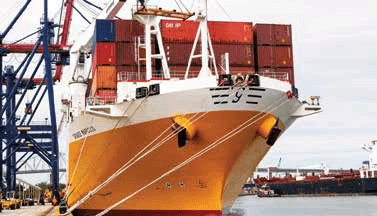 In a very complex governance environment, New York City is responding to an increasingly obsolete and inefficient truck-dependent freight distribution model with a new strategy that invests significantly in maritime solutions.
In a very complex governance environment, New York City is responding to an increasingly obsolete and inefficient truck-dependent freight distribution model with a new strategy that invests significantly in maritime solutions.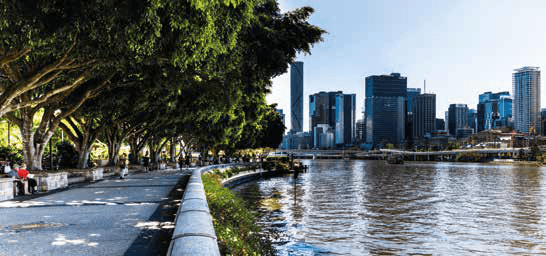 Brisbane City Council’s Green Bridges programme to connect North and South Brisbane more effectively for cyclists, scooters and pedestrians, has maintained its momentum through COVID-19. Involving the construction of at least four bridges, it aims to connect up neighbourhoods that have previously been very hard to reach despite their proximity. In doing so the bridges will get commuters to and from their homes quicker and faster, relieve traffic congestion, and create new landmarks to enjoy.
Brisbane City Council’s Green Bridges programme to connect North and South Brisbane more effectively for cyclists, scooters and pedestrians, has maintained its momentum through COVID-19. Involving the construction of at least four bridges, it aims to connect up neighbourhoods that have previously been very hard to reach despite their proximity. In doing so the bridges will get commuters to and from their homes quicker and faster, relieve traffic congestion, and create new landmarks to enjoy. Vancouver is one of the leading river cities in terms of regulations, pilots and investments to improve river connections, restore habitats, explore multimodal transport, and sustainable living.
Vancouver is one of the leading river cities in terms of regulations, pilots and investments to improve river connections, restore habitats, explore multimodal transport, and sustainable living.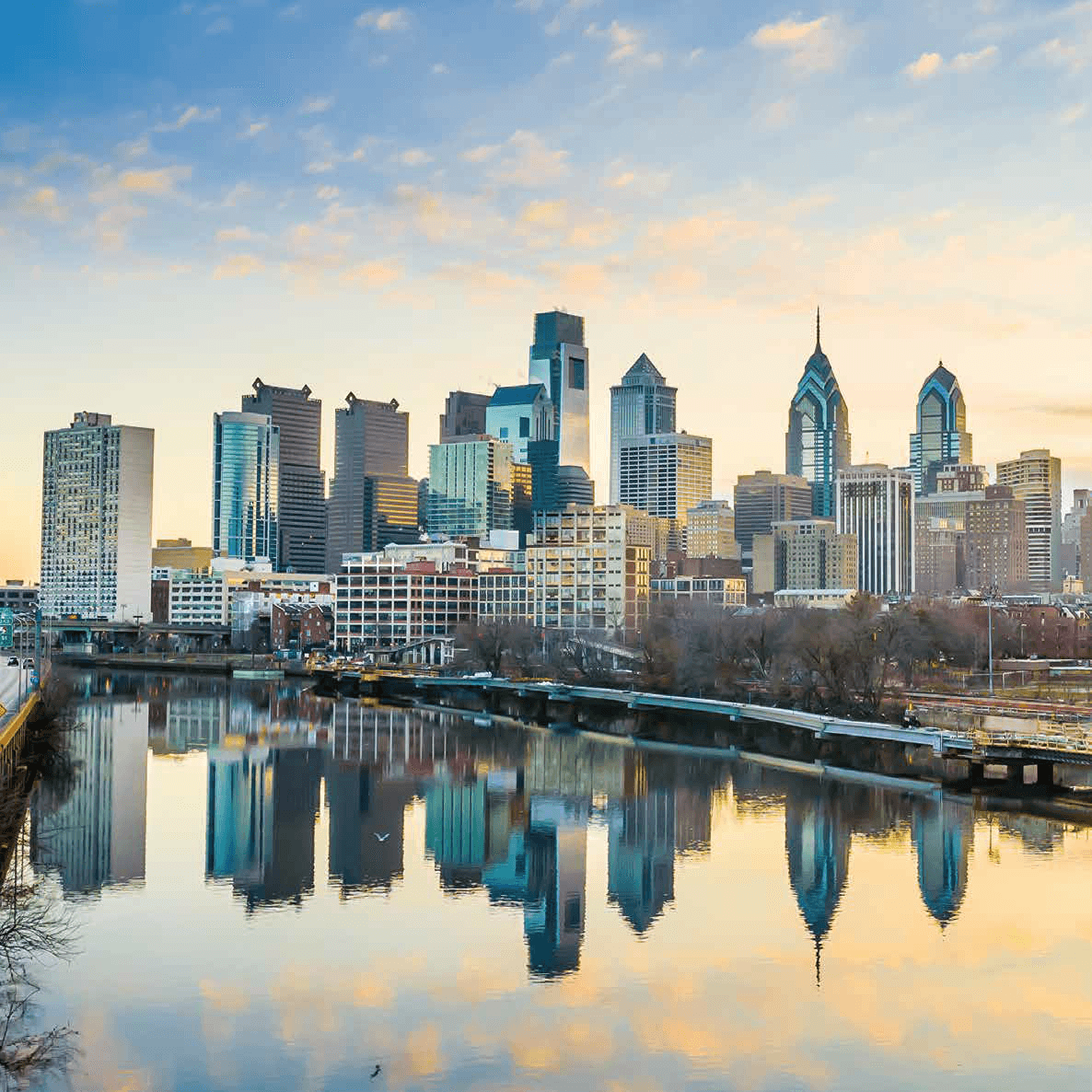
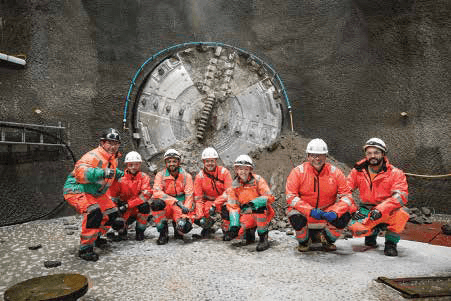 One of the signature projects on the Thames is the Thames Tideway Tunnel project, a 25km tunnel running west to east under the river to intercept, store and transfer sewage waste and rainwater overflow away from the Thames for treatment.
One of the signature projects on the Thames is the Thames Tideway Tunnel project, a 25km tunnel running west to east under the river to intercept, store and transfer sewage waste and rainwater overflow away from the Thames for treatment.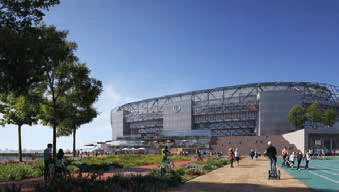 As part of a new 63,000 seat football stadium on the waterfront for club Feyenoord south east of the city centre, the city and major landowners are envisioning a new kind of ‘whole of place’ setting conducive to many kinds of park, leisure and activities. The aim is for much more lively riverfront urban development focused on exercise, play, sports, healthy living, and downtime, dedicated to a wider mix of ages and backgrounds together. A shared vision is forming for a place where work, living and recreation are much more organically blended.
As part of a new 63,000 seat football stadium on the waterfront for club Feyenoord south east of the city centre, the city and major landowners are envisioning a new kind of ‘whole of place’ setting conducive to many kinds of park, leisure and activities. The aim is for much more lively riverfront urban development focused on exercise, play, sports, healthy living, and downtime, dedicated to a wider mix of ages and backgrounds together. A shared vision is forming for a place where work, living and recreation are much more organically blended.